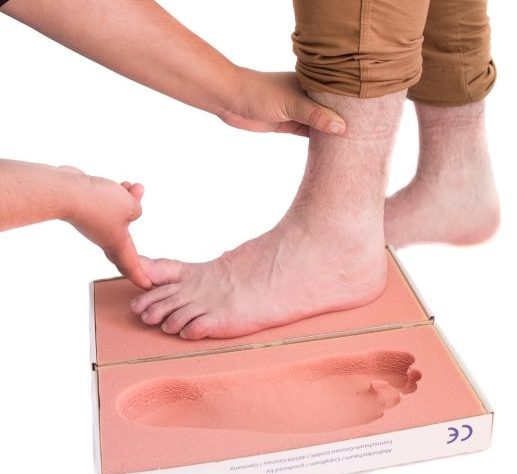
For those that haven’t had orthotics before or vaguely remember them from earlier years, a lot of questions or misconceptions may exist. Orthotics are far from the big, bulky devices that they may have once been. In fact, they become unnoticeable for regular wearers and more than that – a true lifesaver providing much-needed relief from pain and discomfort.
So today, given our speciality in orthotic prescription and manufacture, we thought we’d bust 3 common orthotic myths that may start to shift your hesitation or fear about getting orthotics.
Myth One: I don’t want to wear weird, large shoes…
Great news – you don’t have to! These days, orthotics are made to fit well into your joggers, work shoes, work boots, and a variety of other shoes. Certain women’s brands, like Ziera and Frankie4, stock a wide range of orthotic-friendly sandals and dress shoes too. These brands are actually designed by or with the input of Podiatrists, making them both stylish and incredibly comfortable – and of course, accommodating for orthotics!
The integration of orthotics into general shoes these days is so seamless that you can’t even tell who is and isn’t wearing orthotics. However, there are some shoes that require special types of slimline orthotics, or are unlikely to fit orthotics. Soccer shoes are a great example of requiring slimline orthotics, because of the extremely narrow base of the shoe. Ski boots are another. Shoes like ballet shoes are an example of those that are unable to take orthotics – which really would be pointless (ballet joke…) anyway because of their need to flex.
Myth Two: Once I get orthotics, I’m going to need to keep wearing them…
Nope! False. If you get orthotics to help you recover from an injury, then you only need to wear them until your muscles or tissues fully repair and recover. Now, IF the reason you got injured is something that orthotics can help with, then yes we recommend that you continue to wear your orthotics but only when you’re active and likely to injure yourself again.
For example, say you have very unstable ankles and you suffered an example sprain. And you got orthotics to help hold your ankle in place, facilitate healing, and stop you from rolling and injuring your ankle again while your ligaments are in their damaged and vulnerable state. Then, the ligaments heal and regain full strength and functional capacity. Technically, you don’t need to keep wearing your orthotics. However, if you’re worried about sustaining more ankle sprains in the future, especially because you play basketball (where your initial injury occurred) as it has lots of side to side movements, then by wearing your orthotics during basketball games and training, you can reduce your risk of injury. Which makes sense!
Myth Three: Orthotics don’t work
It’s unfortunate that most people know someone who claims that they’ve had orthotics and they haven’t worked for them. We’ll be as blunt and honest as possible about this one. Say you want an item of glass created by a glassblower for you. If you engage a knowledgeable and experienced glassblower, you’re highly likely to receive the piece that you need. If you engage a junior glassblower that has more of an interest in ceramics than glass, while working for a company that does both, they’re not likely to produce the best result for you, even though they’ve had training in it. The same can be said for hairdressers, financial planners, and so many other professions. But it doesn’t mean that getting custom glass pieces made, getting haircuts, or investing finances doesn’t work. It does. You just need the right person.
That’s why our team specialises in orthotics and we actually make our own, exactly how we want them (and how you need them) from scratch. That’s our difference and why we lead Auckland in this field.
To book an appointment with our expert team, give us a call on 09 523 2333 or book online here.

We’ve all heard how most of us have one foot that is slightly longer than the other. It may be an unnoticeable difference, or it may be half a shoe size – or more. Well, the same goes for the length of our legs! Whether it’s our femur (thigh bone), our tibia (shin bone), or tight muscles that are causing an apparent shorter leg when we walk, many of us will have a shorter leg and not even know about it. But what does this mean? And will it cause any symptoms or pain?
Today, the Perform Podiatry team are talking all about how leg length differences can cause a great deal of pain without you even knowing what is going wrong.
How limb length differences cause you pain
Picture yourself standing straight with one leg being longer than the other. The short leg will be completely straight, and the longer leg will have to bend slightly to compensate for the difference. Your pelvis will be tilted, and the stabilising muscles and ligaments around your hips and pelvis will eventually get used to this tilted position and adjust accordingly. The muscles and alignment of your back will be affected, and the way that you walk will be affected. The longer left leg will have to perform a compensatory movement when it straightens to avoid hitting down into the ground as you walk. You may hike your hip upwards or move the leg out and around as you swing through your step.
As your body compensates and starts moving and using muscles differently, your risk for straining and overloading muscles and joints increases. For those whose leg length differences are big enough to cause symptoms, they may experience:
- Hip pain
- Back pain
- Knee pain
- Muscular strain and tendinopathies
- Uneven loading and pressure distribution between the legs
 How big does the difference need to be to cause pain?
How big does the difference need to be to cause pain?
There is no universal value for how many millimetres of difference causes you pain. It varies from person to person and depends on your body, too.
In our clinic, when we suspect a limb length difference because a patient has come to us with pain, we usually measure a difference of at least ~6mm. With this said, we’ve also seen patients with a 6mm that don’t experience any symptoms.
To confirm that you have a limb length difference, after identifying a notable difference in our clinic (we wouldn’t classify anything less than 3-4mm as ‘notable’), we then refer you for a scan where your bone lengths will be measured radiographically. You’ll receive the precise difference in limb length, and this will help to direct your treatment.
What can be done to help painful leg length differences?
Treating a leg length difference includes both helping to correct the difference, and treating any problems that it has already caused. We start with a comprehensive biomechanical assessment to find out exactly what muscles have been affected so that we know how to best direct your treatment.
We often use custom-prescribed orthotics to help correct the difference by adding a raise to the orthotic for the shorter leg. This helps to equalise the leg length when wearing the orthotics and bring the pelvis and joints back into alignment. We can also make modifications to your shoes to add height to the shoe on the shorter leg.
We’ll then work to help rehabilitate any painful and strained muscles that have become damaged because of the leg length difference. Our goal is to help you stay healthy, happy and pain-free not just now but also for the years to come.
To book an appointment with one of our experienced Podiatrist, you can call us on 09 523 2333 or book online here. We’re located at the One Health building on Remuera Road, just up from Broadway, Newmarket.


 How big does the difference need to be to cause pain?
How big does the difference need to be to cause pain?